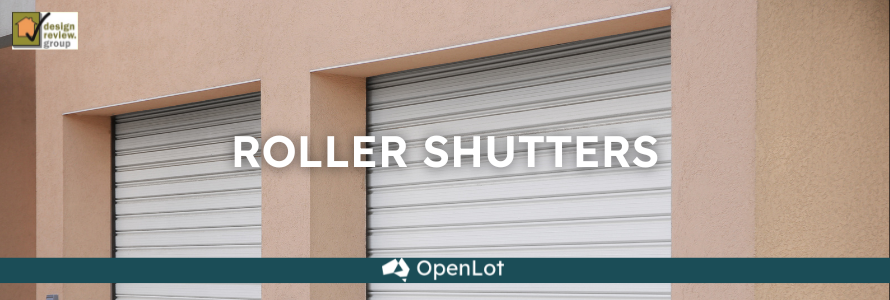
The design codes of most residential estates ban roller shutters if they are visible from the public realm. Is this the best method to control them? While they can be unsightly, they can also be used in a pleasing way. This bulletin describes roller shutters, how they can be positioned, and their problems and opportunities. It finishes with design standards that can be included in an estate’s design code.

Figure 1. Roller shutters can be an eyesore on the front façade of a house.
Design standards about roller shutters are typically worded like this: “Roller shutters are not permitted on facades facing a street or park.” Another example: “Solid security shutters and screens blocking windows are prohibited.”
Roller shutters can be unsightly and can reduce the attractiveness of the streetscape. On the other hand, they protect against break-ins, block the summer sun, reduce noise and help insulate a house. Done well, they can add value to a house.
Should they be prohibited? Should their location and colour require developer approval?

Figure 2. Components of a roller shutter
A roller shutter blind is comprised of the header box, slats, guide rails, and bottom bar. The header box is where the slats are stored when the blind is rolled up. In Australia, because the header box is typically mounted on an outside wall above a window, it becomes very noticeable, as seen in Figure 1 above.

Figure 3. Roller shutter mounting options
However, as Figure 3 shows, the header box can be in four different locations. These are outside, inside, concealed and middle.
In an outside installation, the header box is mounted on the outside wall of the house. To add roller shitters after a house is already built, this is the only mounting option. The header box is prominent.
A roller shutter can be much more discrete if it is designed and constructed at the same time as the house.
An inside installation allows the header box and rails to be hidden from public view. (Figure 4) Because it's inside the window, the blind does not protect the window from the weather, and it insulated less well.

Figure 4: Inside installation
Figure 5 shows a concealed installation. This has the header box and guide rails sitting within the wall.
Figure 6 shows the header box mounted within the window opening.

Figure 5: A concealed installation

Figure 6: A middle installation
Roller shutters become more discrete when matched to their surroundings, such as window frames , piers and the surrounding wall. (Figures 7 and 8).


Figures 7 and 8: Blinds and header boxes are less noticeable when they match their surrounds.
While roller shutters are often unsightly, they can be unobjectionable, and in some instances can even add visual interest to the facades they are on. Rather than banning them, design codes can allow them with developer approval. For example: “Roller shutters must be approved by the DRP prior to installation and must be colour matched to the surrounding façade wall.”
Alternatively, a design standard can control the header box, so that it is discrete or even invisible. Roller shutters must then be integral to the house, not an after-thought.
"Roll down security shutters are not permitted on the front façade of the house if the storage box is visible." (Winterset Lodge- Manor Lakes VIC)
"A roller shutter over a window is prohibited if either the header box or the retracted shutter is visible from the public realm." (Somers & Hervey- Rasmussen QLD)






